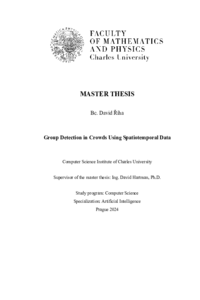Group Detection in Crowds Using Spatiotemporal Data
Detekce skupin v davech pomocí časoprostorových dat
diploma thesis (DEFENDED)

View/
Permanent link
http://hdl.handle.net/20.500.11956/188480Identifiers
Study Information System: 266570
Collections
- Kvalifikační práce [11244]
Author
Advisor
Referee
Neruda, Roman
Faculty / Institute
Faculty of Mathematics and Physics
Discipline
Artificial Intelligence
Department
Computer Science Institute of Charles University
Date of defense
13. 2. 2024
Publisher
Univerzita Karlova, Matematicko-fyzikální fakultaLanguage
Czech
Grade
Excellent
Keywords (Czech)
chování davu|skupiny chodců|detekce skupin|clusteringKeywords (English)
crowd behavior|pedestrian groups|group detection|clusteringTato diplomová práce se zabývá detekcí skupin v davech a představuje algoritmus obohacený o sociologické poznatky o obvyklých formacích skupin mezi chodci. Navrhovaný algoritmus prokazuje srovnatelnou úspěšnost s existujícími řešeními - Time-sequence DBSCAN a Agglomerative Hierarchical Clustering, s využitím datasetu DIAMOR pro testování a porovnání. Kromě toho představujeme validační nástroj, který potenciálně dokáže zdokonalit výsledky existujících algoritmů na základě kritéria pro tvar skupiny, což vede k zlepšení přesnosti identifikace skupin. Klíčová slova: detekce skupin; clustering; analýza tvaru skupin; chování chodců;
This thesis addresses the challenge of social group detection in crowds, presenting an algorithm informed by sociological insights into common group formations among pedestrians. Our proposed algorithm demonstrates comparable performance to existing solutions - Time-sequence DBSCAN and Agglomerative Hierarchical Clustering with Hausdorff Distance, using the DIAMOR dataset for testing and comparison. Additionally, we introduce a validator tool potentially capable of refining results from existing algorithms based on a group shape criterion, leading to improved accuracy in identifying groups. Keywords: groups detection; clustering; group shape analysis; pedestrian behavior;
